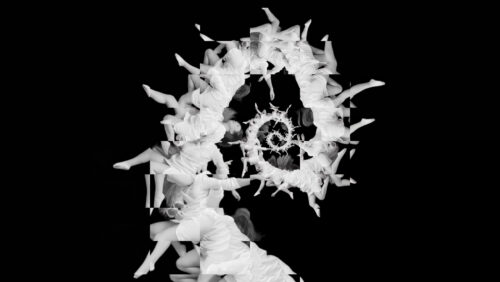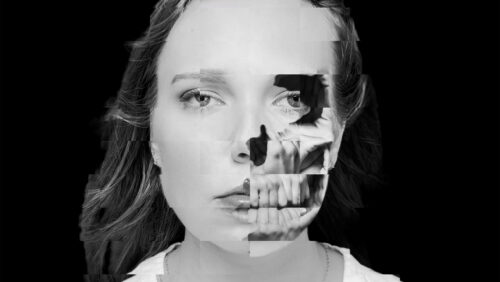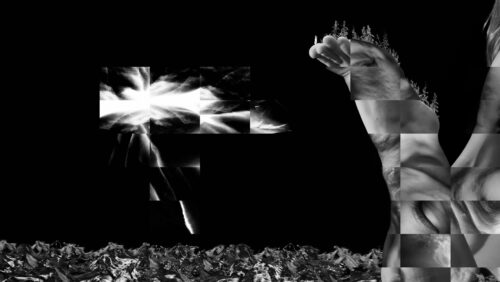Corpus and the Wandering
Corpus et l'exploration divine
Jo Roy
2024
| 7 min 13
Mixed techniques (video compositing, body close-ups filmed with iPhone, stop-motion)
No dialogue
Awards and Festivals
Grand Jury Prize - Experimental Short FilmCalgary International Film Festival, Canada (2024)
Official Selection - Off-Limits CompetitionAnnecy International Animation Film Festival, France (2024)
Official Selection - Screendance CompetitionLeeds International Film Festival, United Kingdom (2024)
Official Selection - Grand Angle SectionLes Sommets du cinéma d’animation, Canada (2024)
Official Selection - ALT Shorts: See and Be Seen Seattle International Film Festival, U.S.A. (2024)
Official Selection Animaphix International Animated Film Festival, Italy (2024)
Official SelectionHollyShorts Film Festival, U.S.A. (2024)
A National Film Board of Canada production
One dancer, one body, one phone.
Modern society lives on the grid. Phone screens, conference calls, cubicles, apartment windows. We are systemically divided by a culture that profits from our collective alienation. When the COVID pandemic first hit, director and dancer Jo Roy was inspired to create a world transcending this insidious framework of consumerism and patriarchy. The result: Corpus and the Wandering, an experimental self-portrait that follows one woman’s journey as she rediscovers her inner compass and kinship with nature. Using only her own body and her iPhone, Roy transforms a 100-screen “videomosaic” grid into a wonderland of the Earth and beyond. A mix of technical innovation and creative vulnerability, Corpus and the Wandering dares to ask how we can remove the walls of a fragmented society and repurpose technology to align with an interconnected future.
ONE-LINER
One dancer, one body, one phone. In a time of collective alienation and technological mass control, one woman rediscovers her soul and reclaims her mind.
TWO-LINER
One dancer, one body, one phone. In a time of collective alienation and technological mass control, one woman rediscovers her soul and reclaims her mind. A short, experimental self-portrait composed of 100 video screens, Corpus and the Wandering transcends the walls of a fragmented grid system to uncover the shared humanity in each of us, and our place in the cosmos.
LONG SYNOPSIS
One dancer, one body, one phone.
Modern society lives on the grid. Phone screens, conference calls, cubicles, apartment windows. Fragmented. We are all alone, together, desperate to connect. And when we do, it is through alienated consumption, as separate from our own selves as we are from one another—what Guy Debord calls “the society of the spectacle.”
When the COVID pandemic first hit, this collective isolation only became clearer, deeper. Deconstructing her own learned ideology, director and dancer Jo Roy challenged herself to create a world beyond the predatory lens of technological mass control. A world defined by kinship with nature and oneness with the environment, interconnected and sprawling, using only her body and her iPhone.
The result: Corpus and the Wandering, an experimental self-portrait that asks what it means to be a flesh-and-blood woman in a digitally driven, patriarchal world. The short film follows a protagonist lost in the wilderness at night. Disoriented, despondent, she slowly becomes attuned to the landscape around her, confronts her grief, and finds her way.
Each scene is made up of 100 videos in a literal 10-by-10 screen grid, what Roy calls her “videomosaic” technique. She strategically isolates and reclaims her own body parts, reimagining them as landscapes, animals and natural phenomena. Eyeballs multiply like cells. Fingertips become flying birds. And locks of hair morph into cubist mountains. All set to an ethereal score by composer and cellist Zoë Keating. The effect is cathartic, surreal and spiritual, though technically meticulous and inspired by biology—for instance, the recreation of a plant’s xylem cell wall using 1,918 images of Roy’s pupils.
The Alberta-born artist has long straddled the creative and commercial worlds, with award-winning ads, music videos and choreography featured in outlets like Ad Age and NOWNESS. In addition to Debord’s work, she cites a number of other texts as inspiration for Corpus and the Wandering, including Braiding Sweetgrass, Staying with the Trouble and Psychopolitics, as well as her personal journeys through existential sorrow, womanhood and Eastern philosophy.
At a time when we live half our lives online, Jo Roy removes the confining lens of the self as commodity to become only herself. And in a world where connection has never felt more constrained, Corpus and the Wandering dares to ask what life lies beyond the grid.
ABOUT THE TECHNIQUE
Using an iPhone to build a world that feels organic and serene was as much a technical challenge as a narrative one for filmmaker and choreographer Jo Roy. There was very little for her to reference while creating her innovative “videomosaic” technique in Corpus and the Wandering. Roy was challenged to design a new workflow and wrangle approximately 50,000 iPhone video file layers. Each shot of the film took up to a month to create, as she hand-placed sometimes several thousand files in a single image, regularly overwhelming the capacity of her computers and compositing programs. And, sometimes, she would finish an image only to find that it fell short of her vision, so she would execute it again. Adding to the undertaking was the difficulty of lighting a makeshift green screen in a tiny space in her bedroom, which led her to employ various surprising objects like cooking tongs, countless medical gloves and a broken space heater. Throughout this playful process punctuated by absurd discoveries and trial and error, Roy endeavoured to recreate as many elements of nature as she could think of, from oceans to lightning, insects to whales. Each image differed completely in the creation strategy, depending on questions of texture, movement and composition. Some shots necessitated stop-motion or intricate compositing, while others required strictly controlled body movement and strategic choreography. Complicating the process further, she committed to never repeating herself in her execution of an element. The resulting short film is a testament to Roy’s talent and tenacity, as she persevered through a tedious process with her sense of humour intact.
DIRECTOR'S STATEMENT BY JO ROY
I made Corpus and the Wandering mostly within the confines of a seven-by-seven-foot space in my bedroom, using only my body and an iPhone. Prompted by COVID-era minimalism, I asked myself a simple question: How can I stretch my skills as a filmmaker by making the most expansive, cinematic film I can conceive, using the fewest possible resources?
Long before I began this film, I had been grappling with many emotions I didn’t have words for; a general, vague air that something is wrong. Individually, we might feel this as a dark night of the soul, or a restless depression, unaware that it’s often the very fabric of our society causing this personal dissonance—and many others are experiencing the same disillusionment, separately.
Over the course of the next three years, I untangled these confusing feelings for myself. I reflected on the “grid structure” that our society has insidiously adapted beyond our awareness: in technology, in how we live and even in our own minds. This systemic fragmentation has become the unspoken language underlying our lives. It produces mass isolation and the endless pursuit of dopamine. Without community and connection, we attempt to fill the void with material objects and superficial validation, to no avail. This fuels a perpetual loop of frustration numbed by consumption. How did we drift so far from the innate tradition of human life that is interwoven with nature? When did we surrender our privacy and the sanctity of an unquantifiable life, only to debase ourselves as commodities vying for contrived measures of worth? Why have we allowed the future to be shaped by a monetary obsession that degrades humans and the Earth? Instead, can we use technology to support a healthy, interdependent world?
As I created Corpus, my personal reflection led me through a web of discovery while exploring science, sociology, Eastern philosophy, womanhood, my own trauma as a living organism, and existential questions around the astonishing reality of being alive. This sprawling journey was accompanied by so many books that I hold close to my heart and that have transformed my worldview, like The Society of the Spectacle, Braiding Sweetgrass, Women Who Run with the Wolves, the Tao Te Ching, Psychopolitics, Staying with the Trouble and The Dragons of Eden.
The technical process of creating this film was the most intricate and tedious exercise I’ve ever taken on as a filmmaker. For each image, I would start with an element of nature, look at my limbs and think, How can I make lightning out of my body? How can I be an ocean? How can I be a sunflower? Through identifying the similarities and mathematical parallels of my body to other entities in the universe and mimicking their movement, I felt that I came to know them in an oddly intimate way. It almost resembled a spiritual practice—a meditation and an expression of gratitude—to transform myself into a diverse array of natural elements. This is especially true since, as a dancer, movement is my form of prayer. My ultimate goal was to somehow transcend the rigidity of the grid format and create a sense of humanity, of curves and connection, that would bring the viewer peace and a feeling of intuitive recognition. I wanted to evoke in them the same innate response as looking at the ocean or a mountain would: rightness and serenity.
My only material was my own body, the body of a woman. This made the process infinitely more intimate and charged, given the controversial significance of female bodies as sites of exploitation, abuse and scrutiny throughout history. My body is exhibited as is, without either “beauty” manipulation to correct flaws or the downplaying of “immodest” attributes. It is presented with sensuality but without sexual objectification, signifying my acknowledgement of the innate sanctity of my physical form. I hope this action can inspire other women to reclaim their bodies as well. Through self-love and healthy caring, we have the power to gradually tune out the predatory lens of the consumerist culture that benefits endlessly from our insecurity and manufactured shame.
As the stormy skies of my own dark night of the soul dissipate, I am struck by the preciousness and beauty of the human experience. For me, this paradigm shift came from deep introspection and reconnection to my inner compass. I continue to identify and reject social messages that do not serve me and are not truthful. As I further my learning, I develop self-compassion and a gentler, more sustainable way of living. Ultimately, I hope that others experience this film as a cathartic support in their own journey.
Corpus and the Wandering is a love letter, a work of healing, and an expression of gratitude to life, to humanity, to nature and to all the people who I’ve had the fortune of being touched by. Thank you.
Trailer
Excerpt
Posters
Images
Loading...

Download
Loading...

Download
Loading...

Download
Loading...

Download
Loading...

Download
Loading...

Download
Contact NFB Publicist for high-resolution images for print.
Team
Jo Roy
Director
Photo
Photo : Roch Armando
Jeremy Mendes
Producer
Photo
Photo : Adam Gilmer
Rob McLaughlin
Executive Producer
Photo
Photo : Emily Cooper
Credits
Director
Jo Roy
Camera
Jo Roy
Choreographer
Jo Roy
Dancer
Jo Roy
Editor
Jo Roy
Music
Zoë Keating
Sound designer
Alexander Verbitskiy
Sound editor
Alexander Verbitskiy
Foley recordist
Alexander Verbitskiy
Synth programmer
Sutter Hellwarth
Synth recordist
Sutter Hellwarth
Foley artist
Craig Ng
Titles
Amos Sussigan
Animation consultants
Amos Sussigan
Dan Lund
Post-production consultant
Ondi Animation Inc.
Technical director
Vincent McCurley
Technical coordinator
Luc Binette
Engineer, development & media
Frank Nadeau
Technology advisor, media technology
Frédéric Sauvé
Specialist, computer systems
Rafi Lokmagozyan
Technologists, production & post production
Sébastien Dion
Fabien Capus
Senior on-line editor
Yannick Carrier
Final mix
Isabelle Lussier
Producer
Jeremy Mendes
Executive producer
Robert McLaughlin
Line producer
Laura Mitchell
Project manager
Janine Steele
Senior production coordinators
Dominique Forget
Jasmine Pullukatt
Studio operations managers
Camille Fillion
Janine Steele
Studio administrator
Victoria Angell
Marketing managers
Laurianne Désormiers
Judith Lessard-Bérubé
Marketing coordinators
Julie Fortin
Jolène Lessard
Publicist
Katja De Bock
A National Film Board of Canada production, 2024
Media Relations
-
About the NFB
For more than 80 years, the National Film Board of Canada (NFB) has produced, distributed and preserved those stories, which now form a vast audiovisual collection—an important part of our cultural heritage that represents all Canadians.
To tell these stories, the NFB works with filmmakers of all ages and backgrounds, from across the country. It harnesses their creativity to produce relevant and groundbreaking content for curious, engaged and diverse audiences. The NFB also collaborates with industry experts to foster innovation in every aspect of storytelling, from formats to distribution models.
Every year, another 50 or so powerful new animated and documentary films are added to the NFB’s extensive collection of more than 14,000 titles, half of which are available to watch for free on nfb.ca.
Through its mandate, its stature and its productions, the NFB contributes to Canada’s cultural identity and is helping to build the Canada of tomorrow.